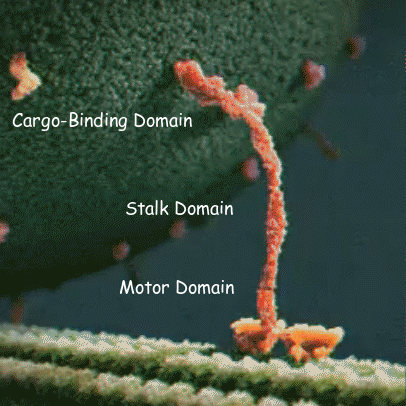#ScienceSaturday posts share exciting scientific developments and educational resources with the KAND community. Each week, Dr. Dylan Verden of KIF1A.ORG summarizes newly published KIF1A-related research and highlights progress in rare disease research and therapeutic development.
KIF1A-Related Research
A Model for Chemomechanical Coupling of Kinesin‑3 Motor
Like humans, KIF1A pairs walk one step at a time, one foot in front of the other. But think about your own walking pattern: How firmly is your front foot planted when your back foot goes into the air? How much do bend your knees for a consistent stride? How do you adjust when you’re carrying something heavy? There are many muscles, joints, and nerves that coordinate our steps, and the better we understand them the better we can improve people’s movement.
KIF1A’s steps are also complex; it moves quickly and for long distances, but can also fall off of the microtubule when resisted. Mapping out each step of KIF1A movement can help us understand why certain mutations cause the problems they do.

Theoretical and Experimental data
KIF1A is so small, and moves so quickly, that it is very difficult to get information about individual steps. Research Network members in the Hancock Lab measure KIF1A by tethering it to (relatively) large beads that resist it with a certain amount of force. Those measurements can be used in models that simulate KIF1A movement in different situations; if a model’s predicted KIF1A movement matches observations from experiments, it’s more likely taking the right details into account.
In this week’s article, a researcher used biochemical data from recent KIF1A studies, including those from the Hancock Lab, and created a model of KIF1A movement to learn more about how it takes steps. The “chemomechanical coupling” from the title refers to how interactions between the two KIF1A feet affect its movement.
The Study
When KIF1A is ready to take a step, the back “foot” detaches from the microtubule; at this point, the detached foot can reattach ahead or behind the front foot, or stay detached, in which case KIF1A will drift off the microtubule. The specific movements that help the detached foot move forward for the next step are still not completely understood.
In this model, the detached foot becomes bound to the front foot for a short time, preventing it from reattaching to the microtubule. To reattach, the detached foot must process ATP, a molecular energy source. Similarly, the attached foot must release ATP’s byproduct, ADP, to let go of the microtubule for its next step. Because these processes take time, KIF1A spends most of its step cycle with one foot in the air.
This model matches recent experimental data, and by providing predictions of KIF1A behavior, it can be further tested with additional experiments to understand how KIF1A moves step by step.
Rare Roundup
Rare Disease Day is this Thursday, February 29th!
When we stick to our silos rare diseases can be isolating, but altogether there are so many incredible people on the search for treatments and cures. This week visit our Rare Disease Day page where you can meet KIF1A superheroes, listen to their favorite jams, buy KIF1A merch or donate, and find rare disease events and info to share with your friends and family!

